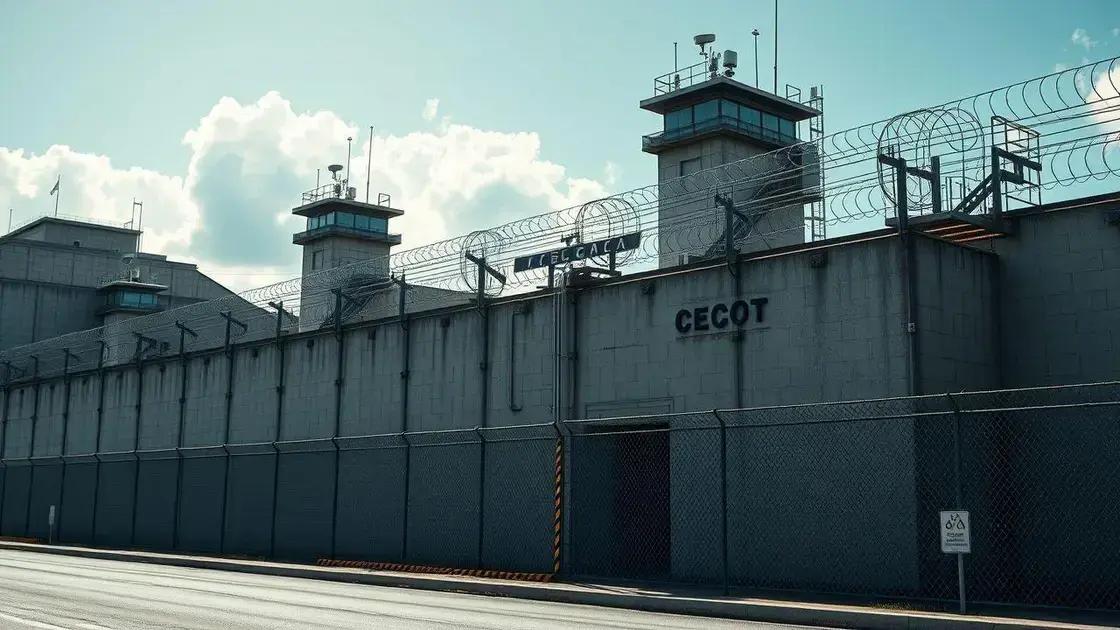A look inside El Salvador’s high-security CECOT prison

A look inside El Salvador’s high-security CECOT prison reveals a strict environment focused on security, with rehabilitation programs aimed at reducing recidivism while addressing significant human rights challenges for inmates.
A look inside El Salvador’s high-security CECOT prison exposes a strict and controversial environment that raises questions about prison reform. What are the experiences of those confined within these walls? Let’s take a closer look.
Understanding the CECOT prison system
Understanding the CECOT prison system is essential to grasp the realities faced by inmates. This facility in El Salvador is a high-security prison designed for the most dangerous offenders. It operates under strict regulations and is under constant surveillance to maintain order.
The architecture and design of the CECOT prison reflect its purpose. The prison features high walls and advanced security measures. These elements ensure that dangerous criminals are kept isolated from the public.
Key Features of the CECOT Prison
The CECOT prison is known for several distinctive features:
- Heavy surveillance systems
- Controlled access to various areas
- Strict rule enforcement for inmate behavior
Life inside CECOT is highly regulated. Inmates have limited freedom, and their daily activities are closely monitored. This system aims to prevent violence and maintain order.
With a focus on security, the management enforces strict guidelines, which can affect inmates’ mental health. Some argue that such intense control can lead to further issues, raising questions about rehabilitation.
Additionally, educational and vocational programs are available, albeit limited. These programs are designed to help inmates develop skills that can aid in their reintegration into society post-release. Though effective in some cases, participation is often not mandatory.
Challenges and Criticisms
The CECOT prison faces criticism for its conditions. Inmates often report overcrowding and inadequate resources. These issues pose significant challenges in providing humane treatment.
The debate continues on whether the prison’s strict measures are effective in reducing recidivism. While some believe in the need for strict security, others advocate for more rehabilitation-focused approaches.
As we explore the complexities of the CECOT prison system, it becomes clear that there are no simple answers. Understanding these dynamics is key to discussing the broader implications for the justice system in El Salvador.
Life inside high-security prisons in El Salvador
Life inside high-security prisons in El Salvador is often harsh and unforgiving. Inmates face a daily routine that is tightly controlled, limiting their freedom and autonomy. Each day in these prisons is structured, and the environment is heavily monitored.
The general atmosphere can feel oppressive. Inmates live in small cells, sometimes overcrowded, with limited personal space. The conditions can be challenging, affecting their mental well-being and sense of identity.
Daily Life for Inmates
Daily routines typically involve:
- Scheduled meals with basic nutrition
- Designated times for outdoor exercise
- Limited opportunities for communication with family
Inmates often engage in specific labor or educational programs. These activities provide some structure but may not be enough to alleviate the isolation felt within these walls. The lack of stimulation can lead to boredom and frustration.
Despite the challenges, some inmates strive to maintain a sense of normalcy. They find ways to cope with the environment, forming friendships and support networks among fellow inmates. These connections can be vital for their survival and mental health.
Rehabilitation and Education Programs
Educational programs are present but vary significantly in quality. Many prisons aim to offer classes that teach valuable skills, such as:
- Vocational training in trades
- Basic literacy and education
- Psychological support sessions
Participation in these programs can be limited, and often, not every inmate has access. Those who do can find them beneficial for rehabilitation, offering hope for a better future.
While some inmates use this time to learn, others struggle with the reality of their situation. The desire for rehabilitation exists, yet the surrounding environment can often hinder progress. Understanding the complexities of life in high-security prisons is essential to comprehending the broader issues of the criminal justice system in El Salvador.
Security measures and their implications

Security measures and their implications in high-security prisons like CECOT are designed to keep inmates and staff safe. These measures are critical in managing the challenges posed by dangerous offenders. Every aspect of security is meticulously planned to prevent escapes and maintain order.
In CECOT, the security system is multifaceted. Surveillance cameras are installed throughout the facility, providing constant monitoring. This technology helps to deter violence and allows authorities to respond quickly to incidents.
Types of Security Measures
The security measures implemented at CECOT include:
- Regular patrols by trained guards
- Strict protocols for inmate movement
- Enhanced perimeter security with barriers and alarms
Each of these points is vital to the prison’s operation. The guards are tasked with overseeing the inmates and ensuring that the rules are followed. Any breach of security can escalate into severe situations.
The strict protocols around inmate movement are also crucial. Inmates typically require permission to move between areas, and their transfers are carefully controlled. This minimizes the chance of conflicts and maintains a secure environment.
Implications of Security Measures
While these measures enhance safety, they also have significant implications for inmate life. The constant surveillance can create an atmosphere of distrust. Inmates may feel that they are not treated as individuals but rather as threats.
The environment can affect rehabilitation efforts as well. If inmates feel dehumanized, it may hinder their willingness to engage in programs aimed at self-improvement. It raises important questions about the balance between safety and humane treatment.
Furthermore, the impact of these security measures can extend beyond prison walls. Communities outside may feel the effects, especially as released inmates reintegrate. Understanding these dynamics is crucial for a holistic view of the justice system.
Human rights considerations for inmates
Human rights considerations for inmates in high-security prisons like CECOT are crucial topics in the ongoing discussions about the justice system. The treatment of inmates can reflect a society’s values and commitment to justice.
Prisoners have rights that should be respected, even while incarcerated. These rights include access to basic necessities, humane treatment, and protection from abuse. It is vital to ensure that these rights are upheld to maintain the dignity of every individual.
Key Human Rights for Inmates
Some essential human rights for inmates include:
- Right to adequate food and healthcare
- Protection against cruel and unusual punishment
- Access to legal representation and fair trials
These points cover the fundamentals needed for a humane prison experience. An adequate diet and health services are not just luxuries; they are vital for the wellbeing of inmates. When these needs are unmet, it can lead to serious health issues.
Protections against cruel and unusual punishments ensure that inmates are not subjected to torture or inhumane treatment. Such practices are not only unethical, but they also violate international human rights standards.
Challenges in Upholding Rights
Despite the established rights, challenges remain in high-security settings. Overcrowding can lead to unsanitary conditions that violate inmates’ rights to health. When facilities are stretched beyond their capacity, it often results in neglect.
Additionally, inmates may face isolation that can impact their mental health. The harsh reality of confinement can make it difficult for inmates to feel like they have any agency. These conditions can stir debates about the effectiveness of current prison policies.
Advocacy groups work tirelessly to raise awareness about these issues and push for reforms. They highlight the importance of balancing security measures with human rights. This advocacy is essential in driving changes that improve the prison experience and promote rehabilitation.
Rehabilitation programs and their effectiveness
Rehabilitation programs and their effectiveness are crucial components of the prison system, especially in high-security facilities like CECOT. These programs aim to reduce recidivism and help inmates reintegrate into society after serving their sentences.
Many rehabilitation programs focus on education, vocational training, and mental health support. These areas are essential for providing inmates the skills and resources needed for a successful re-entry into the community.
Types of Rehabilitation Programs
Some common types of programs include:
- Vocational training in various trades
- Educational classes, including basic literacy and GED preparation
- Therapeutic programs addressing mental health and substance abuse
Each program has its unique focus, but the ultimate goal remains the same: to equip inmates with the tools they need for a better future. Through vocational training, inmates can learn skills that will help them find jobs once released, which is vital for reducing the chances of re-offending.
Educational classes serve a dual purpose. They provide valuable knowledge and help boost self-esteem, which can be low among inmates. Many inmates have not had positive educational experiences before their incarceration, so offering them a chance to learn is transformative.
Effectiveness of Rehabilitation
The effectiveness of these programs can sometimes be difficult to measure. Studies show that inmates who participate in rehabilitation programs are less likely to return to prison. However, several factors influence this success rate, including:
- Inmate motivation and engagement in the programs
- Quality of the programs and available resources
- Support received after release
Motivation is key. Inmates who are genuinely interested in changing their lives often take full advantage of the programs offered. However, if the programs lack quality or resources, their effectiveness diminishes. Support after release is also critical, as many former inmates face challenges re-entering society.
Overall, investing in rehabilitation programs is crucial for breaking the cycle of crime. By focusing on education and personal development, prisons can help create a safer community while providing inmates with the chance for a fresh start.
FAQ – Frequently Asked Questions about El Salvador’s High-Security CECOT Prison
What are the primary goals of rehabilitation programs in CECOT?
The main goals of rehabilitation programs at CECOT are to reduce recidivism and support the successful reintegration of inmates into society.
How are human rights considered in high-security prisons?
Human rights in high-security prisons include ensuring adequate food, healthcare, and protection from abuse, emphasizing the need for humane treatment of inmates.
What challenges do rehabilitation programs face?
Rehabilitation programs face challenges like overcrowding, limited resources, and varying levels of inmate motivation, which can affect their overall effectiveness.
What security measures are in place at CECOT prison?
Security measures at CECOT include constant surveillance, controlled inmate movement, and strict protocols to maintain order and prevent escapes.






